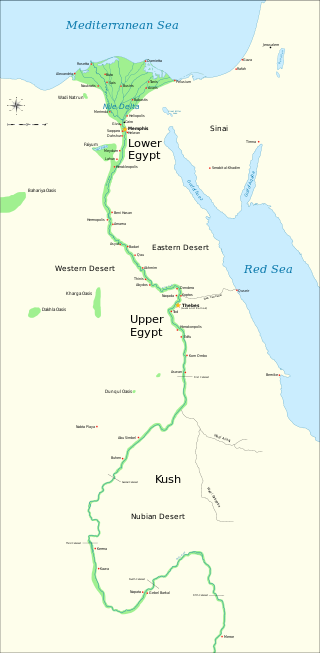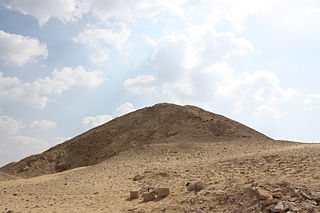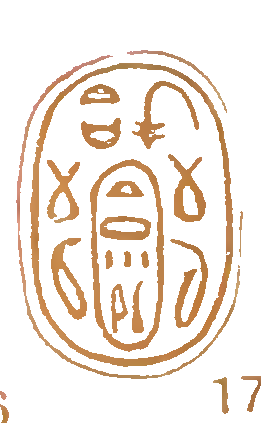
Unas or Wenis, also spelled Unis, was a pharaoh, the ninth and last ruler of the Fifth Dynasty of Egypt during the Old Kingdom. Unas reigned for 15 to 30 years in the mid-24th century BC, succeeding Djedkare Isesi, who might have been his father.

Qakare Ibi was an ancient Egyptian pharaoh during the early First Intermediate Period and the 14th ruler of the Eighth Dynasty. As such Qakare Ibi's seat of power was Memphis and he probably did not hold power over all of Egypt. Qakare Ibi is one of the best attested pharaohs of the Eighth Dynasty due to the discovery of his small pyramid in South Saqqara.

The First Intermediate Period, described as a 'dark period' in ancient Egyptian history, spanned approximately 125 years, c. 2181–2055 BC, after the end of the Old Kingdom. It comprises the Seventh, Eighth, Ninth, Tenth, and part of the Eleventh Dynasties. The concept of a "First Intermediate Period" was coined in 1926 by Egyptologists Georg Steindorff and Henri Frankfort.

Userkare Khendjer was the twenty-first pharaoh of the Thirteenth Dynasty of Egypt during the Second Intermediate Period. Khendjer possibly reigned for four to five years, archaeological attestations show that he was on the throne for at least three or four years three months and five days. Khendjer had a small pyramid built for himself in Saqqara and it is therefore likely that his capital was in Memphis.

Menkauhor Kaiu was an Ancient Egyptian pharaoh of the Old Kingdom period. He was the seventh ruler of the Fifth Dynasty at the end of the 25th century BC or early in the 24th century BC.

Merenre Nemtyemsaf II was an ancient Egyptian pharaoh, the sixth and penultimate ruler of the 6th Dynasty. He reigned for 1 year and 1 month in the first half of the 22nd century BC, at the very end of the Old Kingdom period. Nemtyemsaf II likely ascended the throne as an old man, succeeding his long-lived father Pepi II Neferkare at a time when the power of the pharaoh was crumbling.

Amenemhat IV was the seventh and penultimate king of the Twelfth Dynasty of Egypt during the late Middle Kingdom period, ruling for more than nine years in the late nineteenth century BC or the early eighteenth century BC.

Hedjkheperre Setepenre Takelot I was an ancient Libyan ruler who was pharaoh during the Twenty-second Dynasty of Egypt.

Khasekhemre Neferhotep I was an Egyptian pharaoh of the mid Thirteenth Dynasty ruling in the second half of the 18th century BC during a time referred to as the late Middle Kingdom or early Second Intermediate Period, depending on the scholar. One of the best attested rulers of the 13th Dynasty, Neferhotep I reigned for 11 years.

Khaneferre Sobekhotep IV was one of the more powerful Egyptian kings of the 13th Dynasty, who reigned at least eight years. His brothers, Neferhotep I and Sihathor, were his predecessors on the throne, the latter having only ruled as coregent for a few months.

Hedjkheperre Setepenre Shoshenq IV was an ancient Egyptian ruler of the 22nd Dynasty, between the reigns of Shoshenq III and Pami. In 1986, David Rohl proposed that there were two king Shoshenqs bearing the prenomen Hedjkheperre – (i) the well-known founder of the dynasty, Hedjkheperre Shoshenq I, and (ii) a later pharaoh from the second half of the dynasty, whom Rohl called Hedjkheperre Shoshenq (b) due to his exact position in the dynasty being unknown. Following Rohl's proposal, the British Egyptologist Aidan Dodson supported the new king's existence by demonstrating that the earlier Hedjkheperre Shoshenq bore simple epithets in his titulary, whereas the later Hedjkheperre Shoshenq's epithets were more complex.

The pyramid of Teti is a smooth-sided pyramid situated in the pyramid field at Saqqara in Egypt. It is the second known pyramid containing pyramid texts. Excavations have revealed a satellite pyramid, two pyramids of queens accompanied by cult structures, and a funerary temple. The pyramid was opened by Gaston Maspero in 1882 and the complex explored during several campaigns ranging from 1907 to 1965. It was originally called Teti's Places Are Enduring. The preservation above ground is very poor, and it now resembles a small hill. Below ground the chambers and corridors are very well preserved.

Qahedjet could be the Horus name of an ancient Egyptian king (pharaoh), who may have ruled during the 3rd Dynasty or could be a voluntarily archaistic representation of Thutmose III. Since the only artifact attesting to the ruler and his name is a small stela made of polished limestone of uncertain origin and authenticity, Egyptologists are discussing the chronological position and historical figure of Qahedjet.

Sehetepibre Sewesekhtawy was an Egyptian pharaoh of the 13th Dynasty during the early Second Intermediate Period, possibly the fifth or tenth king of the Dynasty.
Thamphthis is the hellenized name of an ancient Egyptian ruler (pharaoh) of the 4th Dynasty in the Old Kingdom, who may have ruled around 2500 BC under the name Djedefptah for between two and nine years. His original Egyptian name is lost, but it may have been Djedefptah or Ptahdjedef according to William C. Hayes. Thamphthis is one of the shadowy rulers of the Old Kingdom, since he is completely unattested in contemporary sources. For this reason, his historical figure is discussed intensely by historians and Egyptologists.

Bikheris is the Hellenized name of an ancient Egyptian pharaoh, who may have ruled during the 4th Dynasty around 2570 BC. Next to nothing is known about this ruler and some Egyptologists even believe him to be fictitious.

Seankhenre Mentuhotepi was an ancient Egyptian pharaoh during the fragmented Second Intermediate Period. According to egyptologists Kim Ryholt and Darrell Baker, he was the fifth king of the 16th Dynasty reigning over the Theban region in Upper Egypt. Alternatively, Jürgen von Beckerath sees him as the fifth king of the 17th Dynasty.

The pyramid of Merikare is an ancient Egyptian pyramid that remains unidentified, but is attested by inscriptions on funerary steles and possibly is located in Saqqara. The pyramid is presumed to be the burial place of the Herakleopolitan pharaoh Merikare, who ruled toward the end of the Tenth Dynasty c. 2040 BC during the First Intermediate Period. Sometimes, the Headless Pyramid in North Saqqara is identified as the pyramid of Merikare, although the latter is more likely to belong to pharaoh Menkauhor.
Qakare Ini was an ancient Egyptian or Nubian ruler who most likely reigned at the end of the 11th and beginning of the 12th Dynasty over Lower Nubia. Although he is the best attested Nubian ruler of this time period, nothing is known of his activities.

Tati was an ancient Egyptian queen. She is the only queen known by name from the Fourteenth Dynasty. Her position is unknown.

















